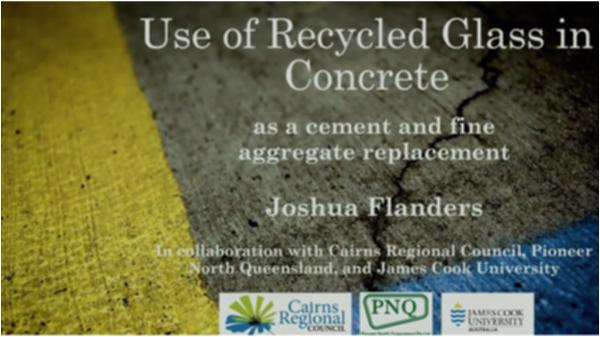Please use this identifier to cite or link to this item:
https://ipweaq.intersearch.com.au/ipweaqjspui/handle/1/3998

Full metadata record
| DC Field | Value | Language |
|---|---|---|
| dc.contributor.author | Flanders, Joshua | - |
| dc.date.accessioned | 2018-10-20T05:33:59Z | - |
| dc.date.available | 2018-10-20T05:33:59Z | - |
| dc.date.copyright | 2018 | en_US |
| dc.date.issued | 2018-10 | - |
| dc.identifier.uri | http://ipweaq.intersearch.com.au/ipweaqjspui/handle/1/3998 | - |
| dc.description.abstract | Concrete is the most widely used construction material in the world, and the second most consumed product after water. It has numerous structural benefits including high compressive strength, durability, and low maintenance. One increasingly critical issue of concrete production, however, is its highly resourceful and energy intensive nature. Portland cement, one of the main constituents in concrete, is responsible for approximately 5% of global CO2 emissions. As such, there is increasing pressure to innovate and improve sustainability in this field. This study aimed to investigate the performance of concrete incorporating recycled waste glass as a partial replacement for natural fine aggregate and Portland cement. The glass used was collected by the Cairns Regional Council in Far North Queensland. The potential environmental and economic benefits of using waste glass to offset portions of cement and natural sand are very significant due to the minimal effort and energy required to transfer the glass into a useable form. To quantify the performance of recycled glass in concrete, a diverse range of fresh and hardened tests were undertaken to understand the effects on workability, hardened strength, and durability, using a total of eight different mix designs. Crushed recycled glass sand (RGS) of nominal size 4 mm was utilised through three mixes as a 20%, 40%, and 60% coarse sand replacement. Similarly, pulverised recycled glass powder (RGP) of nominal particle size 75 μm was incorporated through three mixes as a 10%, 20%, and 30% cement replacement. Results indicated that the use of recycled glass sand as a fine aggregate replacement in concrete was more feasible than the replacement of cement with glass powder, when testing curing times of up to 56 days. There were minimal adverse effects on strength and durability as percentage of sand replacement increased up to 60% indicating suitability at higher replacement levels. The use of recycled glass powder as a cement replacement was plausible at lower replacement levels due to significant decreases in strength as the utilised proportion increased. In all replacement levels, however, timely pozzolanic reactions were evident through analysis of relative compressive strength increases. A comprehensive life cycle analysis was undertaken to quantify the environmental benefits from the use of recycled glass in concrete. Results concluded that less pollutants in the form of CO2, CFC-11, and PO4 were emitted in cement replacement mixes due to the reduction of cement used. The sand replacement mixes provided small environmental benefits compared to control concrete. The main benefit for these mixes was the significant reduction in the use of natural resources as well as the produced economic benefit | en_US |
| dc.publisher | Institute of Public Works Engineering Australasia Queensland | en_US |
| dc.subject | Concrete Design | en_US |
| dc.subject | Glass Recycling | en_US |
| dc.title | Use of Waste Recycled Glass in Concrete as a Partial Cement and Fine Aggregate Replacement by Joshua Flanders | en_US |
| dc.type | PowerPoint | en_US |
| Appears in Collections: | 2018 IPWEAQ Annual Conference, Gold Coast (Presentations) | |
Files in This Item:
| File | Description | Size | Format | |
|---|---|---|---|---|
| STREAM 10.1 Josh Flanders - Recycled Glass.pdf | 4.14 MB | Adobe PDF |  View/Open | |
| Joshua Flanders Slide.png | 563 kB | image/png |  View/Open |
Items in the Knowledge Centre are protected by copyright, with all rights reserved, unless otherwise indicated.
